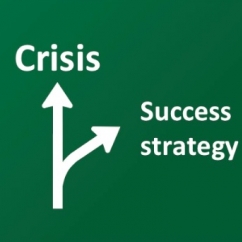Articles and News
What’s The Biggest Threat To Independent Jewelers’ Survival? (Hint: It’s Not The Internet!) | April 08, 2015 (0 comments)

Toronto, ON—Luxury jewelers are doing well so far, but as e-tailers like Blue Nile and Amazon expand their physical footprints and digitally-native Millennials take over the market from Boomers, could jewelers finally become obsolete, along with many other retailers we now take for granted?
Yes, if they aren’t able to turn a disruption in the market to their advantage, says Doug Stephens, a 20-year retail executive, consultant, and founder of The Retail Prophet.com.
“The biggest threat to the independent retailer is complacency,” Stephens told The Centurion in an exclusive interview. “Many independents did extremely well through the old era (i.e. the last 50 years) of retail. They made small fortunes. They're not interested in breaking any more records and many are satisfied delivering average experiences to their customers. That puts them in jeopardy. On the other hand, they have a great advantage in that they can engineer a truly remarkable, customized experience for their customers and execute it brilliantly. They have the potential to deliver what I call a high-fidelity experience, and many do. They can also be very nimble and quick to adapt to changing market and consumer dynamics.
“Their success depends solely on their willingness to learn and embrace the chaos unfolding around them. There are historic opportunities for the taking, but either embrace the changes and see them as the revolutionary opportunities that they are, or sell your business to someone who does. ”

Doug Stephens
Tectonic shifts in demographics, economics, technology and media all seem to be conspiring against traditional retail business models and paradigms, says Stephens. He sees five crises coming that can decimate retail as we know it: 1) replacing staff with technology; 2) e-commerce forcing more store closures; 3) people choosing to share, rather than own, luxury goods; 4) ramped-up demand for honesty and transparency; and 5) 3-D printing at home allowing consumers to simply make many products they now have to buy.
The Centurion asked Stephens how these five crises will impact luxury jewelers.
1. Replacing staff with technology. Between kiosks and robotics, the number of human salespeople on the retail floor is expected to decline, even for high-knowledge positions. But retailers can use technology as an opportunity to re-think the customer experience, says Stephens.
“Where discount retail will view automation as a way to eliminate human workers, high-end retailers will likely see the same technologies as a means of enhancing the value of humans,” he told The Centurion. “For example, Walmart may see a technology like artificial intelligence as something that can be built into kiosks, allowing shoppers to access answers to their questions without the need for a salesperson, Neiman Marcus or Nordstrom will likely see the same technology as a tool that could be put in the hands of their salespeople to enhance their skills and the service level they can provide to shoppers. The same technologies can be deployed to very different strategic ends.”

Is this the future of shopping? Image: TheRetailProphet.com
2. E-commerce forcing more store closures. Although ecommerce is still a relatively small percentage of the total retail market, its global pace of growth is close to 20% year on year, Stephens says. In the first quarter of 2014, Amazon.com registered 23% revenue growth against a virtually stagnant general retail market. Should ecommerce growth continue unabated (there’s little to suggest it won’t) it’s conceivable that by 2025, upwards of 30 percent of all retail purchases could be made online.
This is an opportunity for retailers to re-imagine the strategic value of their stores not as distribution centers but as live-action media that speaks to the brand’s unique attributes, fostering a lasting emotional connection with shoppers. Spend the energy necessary to design and articulate the complete customer experience in-store. Then stop measuring store productivity solely on the basis of sales and profit and begin leveraging a new generation of offline analytic tools to better quantify the experiential value of your stores.
3. People will share more luxury products instead of buying their own. Airbnb already reportedly books more room nights per year than Hilton Hotels, but more importantly, this sharing phenomenon is spreading across just about every category of goods and services from household items and cars to private jets and people who perform a range of tasks, says Stephens. In 2013, sharing economy revenues were estimated at $3.5 billion and growing 25% each year. Some of the drive is purely economic—people looking for less expensive alternatives to ownership—but it’s also happening simply because with technology and social media, it can.
Stephens believes it will be beneficial to luxury marketers, bringing new customers without losing the current base. “I think people who can truly afford luxury goods will continue to buy them, but the sharing economy will make access to these goods possible for a wider segment of the market that couldn't buy them outright,” he told The Centurion. Don’t fight it, facilitate it, he suggests.
But how do you share an engagement ring? You probably can’t, but take bridal out of the equation and anything’s possible. Read The Necklace, a true story of 13 women who pitched in to buy one diamond necklace. A real estate agent saw a $22,000 diamond rivière necklace in the window of Van Gundy Jewelers in Ventura, CA, and convinced 12 of her friends to contribute toward it (one of whom was, in fact, Priscilla Van Gundy). The necklace—nicknamed Jewelia—is timeshared between the owners.
Such a scenario presents exactly the kind of opportunity that Stephens says to seize, and jeweler Tom Van Gundy did. Instead of sending one woman away disappointed, he gained 12 potential customers for other pieces in the future.

These 13 women all share ownership of one diamond necklace. Jeweler Priscilla Van Gundy, right, sold it to them but she also is one of the co-owners. Image: DailyMail.co.uk.
4. Honesty and transparency will be demanded of retailers. This is not news to jewelers, especially with more and more consumers demanding conflict-free origins to their gems. But the reverse is also true and a good reputation can spread through social media as well as a bad one.
“Social media has, to an extent, reversed hundreds of years of mass marketing and made markets much more like they were prior to industrialization. If the town butcher put his thumb on the scale while weighing your order, everyone in town knew about it. The same applies today!”
5. Consumers will be able to 3-D print many products they used to buy. A good consumer-grade 3-D printer is only about $2,000, says Stephens. Right now, it’s more suited to dollar-store items than anything else—but technology never stays stagnant so it’s not inconceivable that customers will someday be able use it for luxury products. And at the speed with which technology has been advancing, that day may come much sooner than anyone anticipates.
But can you really make fine jewelry on a home 3-D printer? It’s not that farfetched, says Steven Adler, founder and president of A3DM Technologies Corp., a leader in state-of-the-art jewelry technology. 3-D printing has already impacted the luxury jewelry industry, he says. Jewelry-manufacturing equipment has shrunk considerably in both size and cost over the past 10 years, to the point where desktop (or bench-top) versions of casting equipment and burnout ovens are available. Add in a 3-D printer and you’ve got manufacturing capability for less than $10,000.
“Someone coming out of the 26-week GIA CAD/CAM class can set up a digital design and manufacturing facility for between $10,000 and $12,000,” he told The Centurion. “That really lowers the barrier to entry.”
But that’s still looking at the technology as it applies to jewelry professionals. And if you’re going to print out a piece of gold jewelry, you have to put gold into the printer. So will consumers someday make their own jewelry and bypass the jeweler?
It’s farther off, but entirely possible. Machines that print gold already exist (available through Adler), and they’re about the size of a refrigerator. Obviously, they cost more than the typical desktop 3-D printer—they’re about $250,000 to $300,000—but they used to cost $1,500,000, says Adler.
The basic bench-top technology already allows someone to design a piece of jewelry and make a prototype, and if they don’t have skills to finish all the elements (such as setting stones) they can send it out for someone else to finish. Programs like Stuller’s Counter Sketch essentially do exactly that, albeit for retailers working in conjunction with the customer. The retailer designs the piece using CAD, then sends the digital file to Stuller to make. But Adler says it’s not inconceivable that a company could set up the same kind of service directly for consumers.
“Consumers might have the ability to buy a one-time license online to print something once,” says Adler.
Top image: kitchmedia.com







